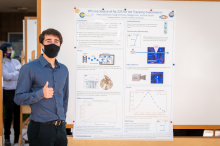
Major:
Mentor(s):
Faculty Sponsor(s):
Faculty Sponsor's Department(s):
Project Title:
Project Description:
The radium-225 ion has advantages over other trapped ions due to its high mass, nuclear spin of ½, and octupole deformed nucleus, all of which are expected to contribute to increases in optical clock performance and improved measurements of CP-violating physics. However, radium-225 is challenging to load into the trapping region of an ion trap due to its 15-day half-life, which prohibits the use of the laser ablation loading technique used in our prior work with radium-226 (half-life 1600 years). In this work, we designed and tested a 3D-printed titanium oven intended to be filled with 10uCi of thorium-229, an isotope of thorium that alpha decays into radium-225 with a half-life of 7900 years. As Th-229 decays inside of the oven, the Ra-225 population will increase inside of the oven. The oven is then resistively heated to temperatures around 800K, where vapor pressure differences between thorium and radium cause Ra-225 to exit the oven while Th-229 stays inside of the device. Successful tests with strontium and barium, the closest elemental analogs to radium, indicate the promise of the effusive radium oven. Upcoming tests with Th-228, a less scarce isotope of thorium which alpha decays into Ra-224, will confirm that the oven functions properly. If successful, the construction of an effusive oven source of Ra-225 will serve as an
